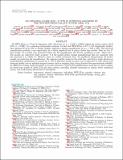Por favor, use este identificador para citar o enlazar a este item:
http://hdl.handle.net/10261/140018COMPARTIR / EXPORTAR:
 SHARE SHARE
 CORE
BASE CORE
BASE
|
|
| Visualizar otros formatos: MARC | Dublin Core | RDF | ORE | MODS | METS | DIDL | DATACITE | |

| Título: | Illuminating a dark lens: a type Ia supernova magnified by the frontier fields galaxy cluster abell 2744 |
Autor: | Molino, Alberto CSIC ORCID; Broadhurst, Tom; Diego, José María CSIC ORCID ; Lam, Daniel; Zitrin, Adi | Palabras clave: | Gravitational lensing: weak Supernovae: general Galaxies: clusters: individual (Abell 2744) Supernovae: individual (HFF14Tom) Galaxies: clusters: general Gravitational lensing: strong |
Fecha de publicación: | 2015 | Editor: | Institute of Physics Publishing | Citación: | Astrophysical Journal 811(1): 70 (2015) | Resumen: | SN HFF14Tom is a Type Ia SN discovered at Z = 1.3457 ± 0.0001 behind the galaxy cluster Abell 2744 (Z = 0.308). In a cosmology-independent analysis, we find that HFF14Tom is 0.77 ± 0.15 mag brighter than unlensed Type Ia SNe at similar redshift, implying a lensing magnification of μ = 2.03 ± 0.29. This observed magnification provides a rare opportunity for a direct empirical test of galaxy cluster lens models. Here we test 17 lens models, 13 of which were generated before the SN magnification was known, qualifying as pure >blind tests. > The models are collectively fairly accurate: 8 of the models deliver median magnifications that are consistent with the measured μ to within 1λ. However, there is a subtle systematic bias: the significant disagreements all involve models overpredicting the magnification. We evaluate possible causes for this mild bias, and find no single physical or methodological explanation to account for it. We do find that model accuracy can be improved to some extent with stringent quality cuts on multiply imaged systems, such as requiring that a large fraction have spectroscopic redshifts. In addition to testing model accuracies as we have done here, Type Ia SN magnifications could also be used as inputs for future lens models of Abell 2744 and other clusters, providing valuable constraints in regions where traditional strong- and weak-lensing information is unavailable. | Descripción: | Facility: HST (WFC3).-- Rodney, Steven A. et al. | Versión del editor: | http://dx.doi.org/10.1088/0004-637X/811/1/70 | URI: | http://hdl.handle.net/10261/140018 | DOI: | 10.1088/0004-637X/811/1/70 | Identificadores: | doi: 10.1088/0004-637X/811/1/70 e-issn: 1538-4357 issn: 0004-637X |
| Aparece en las colecciones: | (IAA) Artículos (IFCA) Artículos |
Ficheros en este ítem:
| Fichero | Descripción | Tamaño | Formato | |
|---|---|---|---|---|
| imuminat2744.pdf | 9,64 MB | Adobe PDF |  Visualizar/Abrir |
CORE Recommender
SCOPUSTM
Citations
68
checked on 17-abr-2024
WEB OF SCIENCETM
Citations
57
checked on 23-feb-2024
Page view(s)
319
checked on 24-abr-2024
Download(s)
200
checked on 24-abr-2024
Google ScholarTM
Check
Altmetric
Altmetric
NOTA: Los ítems de Digital.CSIC están protegidos por copyright, con todos los derechos reservados, a menos que se indique lo contrario.
